Since 1972, the Hawai‘i Council for the Humanities (HIHumanities) has encouraged and supported programming that “binds the people of Hawai‘i together as a stronger community.” HIHumanities is one of 56 state and jurisdictional humanities councils in the US. Organized as the state affiliate of the National Endowment for the Humanities (NEH) in 1972, HIHumanities is now a 501(c)3 organization. Its key programs include the annual Hawai‘i History Day which engages elementary and high school students in the interpretation of history; robust grant programs; and other community events.
HHF reached out to the executive director of HIHumanities, Aiko Yamashiro, to learn more about her own connection with history and path to the present.
HHF: Please tell us about yourself—where were you born and raised? What were you like as a kid?

Aiko Yamashiro, Executive Director of Hawai‘i Council for the Humanities
I grew up in Kāneʻohe. My dad really liked to talk about history, and his own family’s history there as Okinawan immigrants. My great-grandfather came over from Okinawa, and our families worked as peddlers, sold farm produce too, and then my grandparents’ generation were mechanics and okazuya-owners. So Kāneʻohe was full of those kinds of stories for me. As a kid I loved reading and playing ʻukulele. My first job was as an ʻukulele instructor at Roy Sakuma Studios in Kāneʻohe. I got to meet a lot of kids and families that way. In high school I played in the band, and we would play at football games. Castle HS won the OIA championship in 2002. That was so exciting; the town lined the streets with signs waiting for the buses to come home late that night. Looking back, I feel grateful to have been a part of Kāneʻohe in all these ways. Yet the Kāneʻohe I knew was also not the small town it used to be, and there was so much I did not know about this place I grew up in. I think a lot of my work now is about supporting and sharing resources that help people feel more connected to history, to culture, to each other, so that sense of community can feel really strong.
HHF: HIHumanities offers several programs that encourage broader engagement in the Humanities. Could you briefly describe some that you’re working on right now? What are the outcomes that you seek to achieve?
We give grants for public humanities programming and resource preservation every year, and our next grant deadline is May 31, 2022.
In June, we are “virtually” sending 50 Hawaiʻi student winners (grades 7–12) to National History Day. This year, for the first time ever, some of those students will be sharing their projects entirely in ʻōlelo Hawaiʻi, as part of a special showcase in partnership with the National Museum of the American Indian and the Smithsonian’s Asian Pacific American Center.
We run “Try Think,” a community-building conversation program on different themes every month online; the current theme is “Civic Love.”
This summer we will be launching a new initiative with the State Foundation on Culture and the Arts and the Hawaiʻi State Public Library System: a Hawaiʻi State Poet Laureate program.
With all of these programs, we hope to activate the rich humanities–histories, stories, philosophies, poems–that already exist in our communities. We hope to create spaces for questioning, listening, sharing openly…all the things that help us learn and connect more deeply with each other.
HHF: How did you help your team navigate through the challenges of the pandemic and–dare I say the timeworn word–pivot? What were some of the key transitions you made together?
I joined HIHumanities a year before the pandemic started, and it has been quite a humbling experience as a team to learn together to adapt as quickly as we could, to keep each other safe, and to learn how the humanities can help to nourish and strengthen our communities during crisis. One big pivot was exponentially increasing our grantmaking: we gave out close to 1 million dollars in emergency grants to humanities organizations and projects throughout the state, thanks to federal CARES and ARP funding. This taught us a lot about how expansive and valuable our humanities community is, and how unique to Hawaiʻi. For example, we know cultural organizations “feed our souls” but mālama ʻāina organizations in Hawaiʻi literally feed people as well as restore environments, while also nourishing our spirits.
Another huge pivot we made was gathering virtual educational resources for our teachers, students, and families. Museums, historical societies, libraries, were all creating wonderful free virtual tours and databases and experiences, and we helped to bring some of these together in one place for people to see the true wealth of our local humanities community. The humanities support strong healthy communities in so many ways, and I think our organization can help to connect these sources of wisdom and creativity with each other.
HHF: What are some of the things you like to do in your free time?
Surfing keeps me humble and helps me remember what clean motion feels like. I also love learning more about food and our cultural and personal stories around food, and all the ways food helps us take care of this ‘āina. And I am trying to get better at Okinawan dance, thanks to patient teachers.
HHF: Where are some of your favorite historic places in the Islands?
Oh no, I always have such a hard time picking a favorite. Your event coming up on June 3rd sounds really wonderful, the Honokaʻa Story Map Project. We visited Honokaʻa Heritage Center a few weeks ago and were blown away by the intimacy and care you can feel in their collections and in the way they are trying to grow. The photos on exhibit, for example–so many of them identify the people in them. Nicole Garcia (executive director of the Heritage Center) told us that when members of the community see the exhibit with their families, they point proudly to the photos and say, “Look, that’s Uncle!” or “I see Aunty!”
About a month back, we visited with Kauluakalana, an organization taking care of Ulupō Heiau in Kailua Oʻahu, and restoring and re-storying Kawainui as the second largest traditional Hawaiian fishpond in our entire island chain. Kaleo Wong shared that one of their major tools is making moʻolelo of that place come alive for youth, so that they can vividly understand and help make true the reality of Kawainui not being a marsh or swamp, but a center of community abundance and sustenance.
Instead of picking a favorite historic place, I’d rather say that I really love whenever a community feels that deep ongoing connection to their historic places. When a place feels known and cherished, and going there feels like discovery and belonging at the same time. When you, too, feel a part of the history and a part of the future. I am so grateful for everyone who mālama this deep feeling of community. Mahalo, HHF!
 Learn more about the work of Hawai‘i Council for the Humanities via its website.
Learn more about the work of Hawai‘i Council for the Humanities via its website.
HHF has received grants support from the Hawai‘i Council for the Humanities for the Preservation of the Nancy Bannick Collection at the Hawai‘i State Archives; Sustaining the Humanities through the American Rescue Plan; and HHF publications, Hawaii Modern, Hawaii Civic and Kauai Modern.

